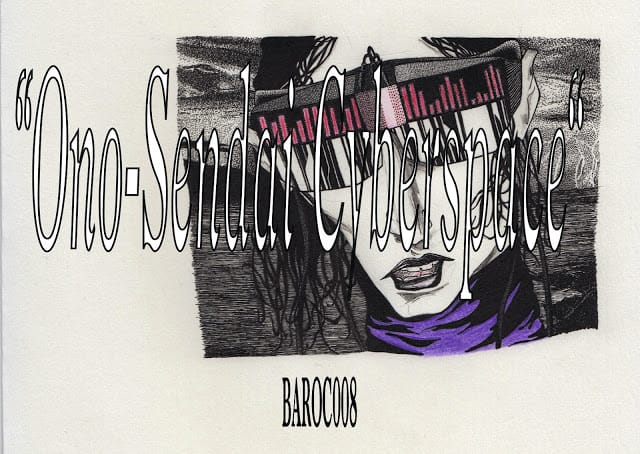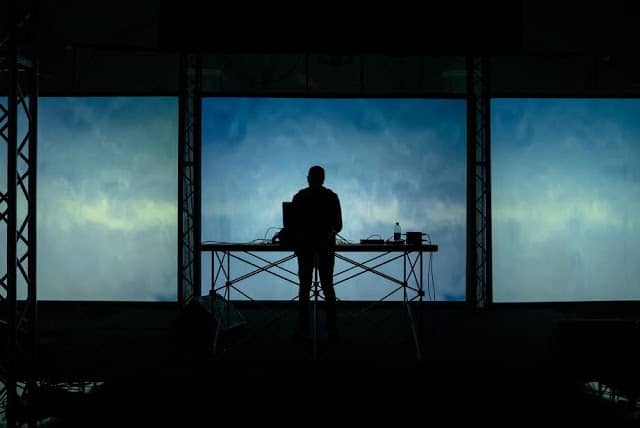Lo scorso 5 Febbraio la vinyl-only label BAROC, da Colonia, ha rilasciato il 12” dal titolo Ono-Sendai Cyberspace firmato da Morkebla, al secolo Alberto Rosso. L’artista è autore da diversi anni a questa parte di interessanti uscite su molteplici labels, formati (validissime le tre cassette edite nel 2014 da Reckno, Where to Now? ed Indole Records) e stili. L’ambito di inquadramento generale in termine di genere musicale è piuttosto sfuggevole, di conseguenza scegliamo di riportare le parole inserite nella descrizione artista su Last.fm in quanto piuttosto appropriate: “Morkebla is [..] an experimental electronic music producer making cinematic atmospheres, finding darker ground somewhere between early Oneohtrix Point Never, Lars Holdus and David Lynch soundtracks”.
Il disco in questione vede la luce nel 2016 ma raccoglie materiale registrato (‘somewhere in Northern Italy’) sul finire del 2014, come riportato nella press-release. Addirittura, mixato in seguito a chirurgia, anestesia e antidolorifici – il tutto è stato prontamente spiegato da Alberto stesso in questa interessante intervista su Dance Like Shaquille O’Neal ad opera di Davide Olivero. Il package del 12” prevede un sacchetto della spazzatura di plastica nero che avvolge il vinile, e su di esso incollata l’artwork ad opera di Bernhard Heuser.
TRACKLIST
1 – RE-2001 (3:25)
2 – Derm (3:20)
3 – De-Ghost Metalink (4:08)
4 – Hypnovel (5:57)
5 – Floor-melting Smileys (3:07)
6 – ASFR Lover (3:46)
7 – The Third Place (2:45)
Il richiamo più evidente, a partire dal titolo e passando per la copertina, è quello alla Sprawl Trilogy scritta da William Gibson tra il 1984 ed il 1988, uno dei più noti ispiratori della cultura cyberpunk oggi oggetto di forte rivalutazione e rielaborazione in molteplici contesti, musicali e non. Da wikipedia:
Ono-Sendai is a fictional Japanese corporation and manufacturer of cyberdecks []. In the short story “Johnny Mnemonic,” Ono-Sendai is mentioned as producing a type of diamond analogue which leads the reader to believe that they are more of a manufacturer of specific, high-tech devices and products which are not usually available to the private sector. The cyberdeck mentioned in the story is an “Ono-Sendai Cyberspace 7. via
Il lavoro rappresenta un’interessante deviazione dalle tipiche alternanze tra cupe pulsazioni e silenzi statici proposte dal musicista, ad esempio, nello split Morkebla / Best Available Technology (Settembre 2015) ed in diverse altre occasioni. L’intento principale della release su BAROC sembra essere piuttosto quello di descrizione / definizione di ambientazioni e tematiche legate, più o meno direttamente, al mondo della fantascienza cyberpunk. Ciò è confermato dall’ampia continuità di suoni utilizzati all’interno delle tracce (per i beat e qualche kick, ad esempio), che rendono il 12” un disco coerente ed omogeneo. L’operazione raggiunge, come risultato complessivo, qualcosa di simile ad una raccolta di sketches estratti da un’ipotetica soundtrack di un film cyber sci-fi, dove l’attenzione è posta più sulla componente emotiva che sulla raffigurazione di paesaggi distopici degradati ed alienanti.
[Raccomandiamo lo show Fading Somewhere Else su Resonance Extra assieme ai Dalhous]
Per una durata attorno ai 28 minuti, le sette tracce si dividono in tre sul primo lato, e quattro sul secondo. L’apertura del disco è affidata a RE-2001, un’intro atmosferica che spazia tra fruscii ed improvvisi cambi di pitch, a rievocare distorsioni e stonature tipiche del mondo analogico / vhs. L’immediata immagine suscitata nell’ascoltatore è di piovose periferie di città ultra-tecnologiche a là Blade Runner, chiacchiere lontane e luci sfocate. Derm è una nebulosa espressione di temi futuristici caratterizzata da un beat secco e kicks Detroit-iani, il cui titolo è derivato anch’esso dalla trilogia Sprawl: “[derm is] an adhesive patch applied to the skin in order to transmit a drug transdermally. [] Derms are used [also] to administer an anaesthetic substance” (via). Il lato A si chiude con De-Ghost Metalink, in cui suoni di clap emergono dal costante battito rumoroso di sottofondo, affiancati da divagazioni da tape-manipulation e sorprendenti passaggi pure-dancefloor.
[Una take dal DJ-set di Morkebla per l’afterparty all’AC Hotel Torino, Club to Club 2015 Day #3 // Visita qui la nostra sezione LIVE]
Il secondo lato della release si apre con Hypnovel, traccia in cui, come suggerito dal titolo, una voce distorta, profonda e cupa narra brevi brani di una storia alla stregua di una vero e proprio mantra ipnotico. Segue Floor-Melting Smileys, una delle tracce vertice dell’album, definita da un beat in 4/4 a bassi bpm inserito su tappeti di synth e sonorità acid. ASFR Lover evoca il robot-fetishism, ed è (inconsciamente o meno) il pezzo più Oneohtrix/James Ferrar-iano di Ono-Sendai Cyberspace. La traccia suona vagamente come una marcia rallentata e sghemba, sulla quale si scatenano veloci istanti più movimentati in qualche modo legati alla tensione (weird-) sessuale del titolo.
Robot fetishism is more commonly referred to by the initials “ASFR” from the now-defunct Usenet newsgroup alt.sex.fetish.robots. Many devotees of this fetish refer to themselves as technosexual []. ASFR can be divided into two distinct but sometimes overlapping types of fantasies.
The first of these is [] a desire to have a ready-made android partner [] for sex, companionship, or any combination of the two. The main distinguishing feature [] is that the android is a completely artificial construct, often manufactured solely to fulfil the wishes of its owner [“built”]. The second [] involves a human who has been either willingly or unwillingly turned into an android. That person can be either oneself or one’s partner, or both. It is usually the process [] (through whatever means it is achieved) that is the focus of this fantasy. [“transformation”]. http://vudhikiat90.tumblr.com/ http://asfr.wikia.com/wiki/Asfr_Wiki
Infine, la track conclusiva The Third Place reitera il caratteristico beat percussivo usato all’interno di tutto l’album per concludersi bruscamente in un eco finale. Ono-Sendai Cyberspace è complessivamente un lavoro ben riuscito ed organico, dal quale emerge chiaramente la grande attenzione dedicata alla produzione di ogni singolo momento del 12” da parte dell’artista, cui va il merito di aver saputo efficacemente accordare le ambientazioni definite attraverso i suoni proposti con l’immaginario suggerito dai vari titoli e dalla grafica.
Unico appunto che ci sentiamo di fare (in nessun modo pregiudizievole rispetto al valore del disco) è legato alla durata della release, le cui idee avrebbero potuto essere sviluppate ed elaborate per qualche istante (o traccia) in più senza pericolo di risultare ripetitive o scontate. Ci rimettiamo ad ogni modo al giudizio ed alla scelta del producer, che continueremo a seguire assiduamente. Comprate Ono-Sendai Cyberspace qui. Support Morkebla.
Track 5 original drum samples by BAT. Mastered by Rashad Becker at Dubplates & Mastering, Berlin. Special thanks to BAROC and everyone who dreams about future landscapes out there.
ENGLISH VERSION
Translation by Andrea Dellapiana
On February the 5th of this year, the vinyl-only record label BAROC, based in Cologne, released a 12” titled Ono-Sendai Cyberspace by Morkebla, originally named Alberto Rosso. From a few years the artist is author of many interesting releases on various labels, formats (extremely valid the three cassette-tapes published in 2014 by Reckno, Where to Now? and Indole Records) and styles. The general placement range in terms of musical genre is quite slippery, so we simply report the words from the “artist description” on Last.fm, being them rather appropriated: “Morkebla is [..] an experimental electronic music producer making cinematic atmospheres, finding darker ground somewhere between early Oneohtrix Point Never, Lars Holdus and David Lynch soundtracks”.
The record in question is seeing the light of the day in 2016 but it actually gathers material recorded during late 2014, as reported by the press-release. Even, mixed after some surgery, anesthetic and painkillers – everything promptly explained by Alberto himself in this very interesting interview on Dance Like Shaquille O’Neal by Davide Olivero. The 12” package features a black rubbish bag wrapped around the vinyl, and the artwork by Bernhard Heuser glued onto it.
TRACKLIST
1 – RE-2001 (3:25)
2 – Derm (3:20)
3 – De-Ghost Metalink (4:08)
4 – Hypnovel (5:57)
5 – Floor-melting Smileys (3:07)
6 – ASFR Lover (3:46)
7 – The Third Place (2:45)
The most obvious call-back, starting from the title and the cover, is the one to the Sprawl trilogy written by William Gibson between 1984 and 1988, one of the best known founders of the cyberpunk culture that has been reevaluated a lot these days and re-interpreted in many contexts, both musical and non-musical. As Wikipedia recites:
“Ono-Sendai is a fictional Japanese corporation and manufacturer of cyberdecks []. In the short story “Johnny Mnemonic,” Ono-Sendai is mentioned as producing a type of diamond analogue which leads the reader to believe that they are more of a manufacturer of specific, high-tech devices and products which are not usually available to the private sector. The cyberdeck mentioned in the story is an “Ono-Sendai Cyberspace 7.” via
The music in this record represents an interesting deviation from the typical variations between dark pulses and static silences that the musician usually proposes: for example in the split Morkebla / Best Available Technology (September 2015) or in many other occasions. The main intent of the release on BAROC appears to be that of describing and defining settings and themes bound, more or less directly, to the world of cyberpunk science fiction. This is confirmed by the vast continuity of sounds used throughout the tracks (as for the beats and some of the kicks, for example), that make the 12” a cohesive and homogenous record. The operation reaches its overall result ending up as something similar to a collection of sketches selected from an hypothetical cyber sci-fi movie soundtrack, in which the attention is more focused on the emotional side rather than on the representation of unrealistic, degraded and alienating landscapes.
[We highly reccommend Morkebla’s Fading Somewhere Else show on Resonance Extra together with Dalhous ]
With a total length of 28 minutes, the seven tracks are three on the first side and four on the second one. The opening track is RE-2001, an atmospheric introduction stretching between swishes and sudden pitch variations that evoke in the listener’s mind those distortions typical of the analogic/vhs world. What comes to mind is that rainy and ultra-technologic suburb a là Blade Runner, all chatter in the background and blurry lights. Derm, with its dry beat and detroit-ian kicks, is a hazy expression of futuristic themes, whose title derives itself from the Sprawl trilogy: “[derm is] an adhesive patch applied to the skin in order to transmit a drug transdermally. [] Derms are used [also] to administer an anaesthetic substance” (via). Side A is over with De-Ghost Metalink, in which the clap emerges from the constant and noisy pulse in the background and is followed by moments of tape-manipulation and unexpected passages of pure dancefloor.
The second side begins with Hypnovel, a track in which, as the title suggests, a distorted, profound and deep voice tells very shorts fragments of a story, in the same manner of a proper hypnotic mantra. Then Floor-Melting Smileys follows: one of the key tracks in the album, with its bass-y 4/4 beat on layers and layers of synths and acid sounds. ASFR Lover evokes robot-fetishism and is (willing or not) the piece that sounds the most Oneothrix Point Never/James Ferrar-like in Ono-Sendai Cyberspace. The track vaguely resembles some kind of slowed-down and crooked march, on which more animated moments, somehow related to the sexual tension suggested in the title, are unleashed.
[] Robot fetishism is more commonly referred to by the initials “ASFR” from the now-defunct Usenet
newsgroup alt.sex.fetish.robots. Many devotees of this fetish refer to themselves as technosexual []. ASFR can be divided into two distinct but sometimes overlapping types of fantasies.
The first of these is [] a desire to have a ready-made android partner [] for sex, companionship, or any combination of the two. The main distinguishing feature [] is that the android is a completely artificial construct, often manufactured solely to fulfil the wishes of its owner [“built”]. The second [] involves a human who has been either willingly or unwillingly turned into an android. That person can be either oneself or one’s partner, or both. It is usually the process [] (through whatever means it is achieved) that is the focus of this fantasy. [“transformation”]. http://vudhikiat90.tumblr.com/ http://asfr.wikia.com/wiki/Asfr_Wiki
Finally, the closing track The Third Place reiterates the typical percussive beat used throughout the whole album, ending in an abrupt final echo. Ono-Sendai Cyberspace is overall a successful and organic album and it clearly emerges the striking attention of the artist in the production of all of its details and his ability to perfectly blend the various musical landscapes in the music with the titles and the graphic.
The only remark we feel we could point out (not detracting in any way the record’s quality) is linked to the release length, whose ideas could have been developed and elaborated for a few minutes or tracks more without ending up as repetitive or predictable. Anyway, we trust the productor’s judgement and choices and we’ll keep on following him. Buy Ono-Sendai Cyberspace here. Support Morkebla.
Track 5 original drum samples by BAT. Mastered by Rashad Becker at Dubplates & Mastering, Berlin. Special thanks to BAROC and everyone who dreams about future landscapes out there.
Are you enjoying what you see on PAYNOMINDTOUS? If that’s the case, we’d like to kindly ask you to subscribe to our newsletter, our Facebook group, and also to consider donating a few cents to our cause. Your help would be of great relevance to us, thank you so much for your time!
PAYNOMINDTOUS is a non-profit organization registered in December 2018, operating since late 2015 as a webzine and media website. In early 2017, we started our own event series in Turin, IT focused on arts, experimental, and dancefloor-oriented music. We reject every clumsy invocation to “the Future” meant as the signifier for capitalistic “progress” and “innovation”, fully embracing the Present instead; we renounce any reckless and ultimately arbitrary division between “high” and “low”, respectable and not respectable, “mind” and “body”; we support and invite musicians, artists, and performers having diverse backgrounds and expressing themselves via variegated artistic practices.


